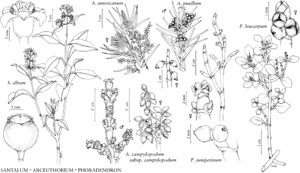Phoradendron
J. Acad. Nat. Sci. Philadelphia, n.s. 1: 185. 1848.
Subshrubs, evergreen, monoecious or dioecious; hemiparasitic on branches of woody angiosperms and gymnosperms, infections localized [systemic]. Stems single or multiple; branching percurrent (branches with single main axis) [pseudodichotomous]. Leaves scalelike or well developed. Inflorescences axillary or terminal, unisexual (bisexual in P. rubrum), spikelike thyrses with intercalary meristems; flowers borne in cavities or grooves. Staminate flowers: petals (2–) 3 (–4), triangular, distinct; stamens (2–) 3 (–4); anthers 2-locular, dehiscing by transverse-slits; nectary absent. Pistillate flowers: petals (2–) 3 (–4), triangular, distinct; ovary 1-locular; style short; stigma undifferentiated [2-lobed]. Berries sessile, not explosively dehiscent, 1-colored, smooth or puberulent, petal remnants persisting at apex. Seeds mucilaginous when removed from fruit, endosperm flattened, ovate to elliptical in broadest outline; embryo oriented longitudinally. x = 14.
Distribution
United States, Mexico, West Indies, Central America, South America
Discussion
Species ca. 244 (7 in the flora).
Although not particularly diverse in the United States, Phoradendron underwent a massive radiation in Mexico, Central America, and South America. The first modern taxonomic treatment of the genus was by W. Trelease (1916), who named 240 species. More recently, J. Kuijt (2003) produced a monograph that included 234 species, but the similarity in number belies the fact that only 18 of the names accepted by Trelease were retained.
Phoradendron is closely related to Dendrophthora Eichler (a genus of 125 species), separated from it only by the presence of 2-locular versus 1-locular anthers. Whether these two genera are monophyletic remains to be tested using molecular methods (V. E. T. M. Ashworth 2000). Together Phoradendron and Dendrophthora are important components of mesic and arid environments in the New World, particularly because their fruits provide food for various bird species that disperse their seeds.
In the key and descriptions that follow, basal pyllotaxy refers to the orientation of the basal pair of leaves or cataphylls on a lateral branch. When those leaves or cataphylls are in the same plane as the main and lateral branch, basal phyllotaxy is median; when they are at right angles to that plane, it is transverse. Flower seriation refers to the arrangement of flowers on fertile internodes (J. Kuijt 2003). Different seriation may occur in staminate and pistillate inflorescences of the same species (for example in Phoradendron californicum). Flowers typically are arranged in one or more columns above each bract, and each set of columns is topped by a single median flower. Each fertile internode has two sets of flower columns, one above each of the opposite bracts. When two columns of flowers occur above the bract, the condition is called biseriate. When three columns of flowers occur, the condition is triseriate. Uniseriate and multiseriate conditions exist, but only outside the flora area. When only three flowers occur above each bract, seriation cannot always be determined (for example in P. juniperinum).
Selected References
Lower Taxa
Key
| 1 | Leaves scalelike. | > 2 |
| 2 | Stems green to olive green, glabrous; inflorescence fertile internodes usually 1; parasitic on gymnosperms, frequently Calocedrus and Juniperus. | Phoradendron juniperinum |
| 2 | Stems grayish green to reddish green (in full sun), densely hairy (hairs silvery white, closely appressed), becoming glabrate; inflorescence fertile internodes (1–)2–4(–6); parasitic on angiosperms, frequently Prosopis, Senegalia, or Vachellia. | Phoradendron californicum |
| 1 | Leaves well developed. | > 3 |
| 3 | Basal phyllotaxy median. | > 4 |
| 4 | Stems densely stellate-hairy; plants dioecious; Arizona, New Mexico, Texas. | Phoradendron capitellatum |
| 4 | Stems glabrous; plants monoecious; Florida. | Phoradendron rubrum |
| 3 | Basal phyllotaxy transverse. | > 5 |
| 5 | Staminate and pistillate inflorescences 3–6 mm; pistillate inflorescence fertile internodes each 2-flowered; parasitic on Abies, Cupressus, and Juniperus. | Phoradendron bolleanum |
| 5 | Staminate and pistillate inflorescences 10–80 mm; pistillate inflorescence fertile internodes each (4–)6–11(–24)-flowered; parasitic on angiosperms. | > 6 |
| 6 | Flowering Oct–Mar; stem internodes 8–59 mm; berries glabrous. | Phoradendron leucarpum |
| 6 | Flowering Jul–Sep; stem internodes 1.5–3.8 mm; berries puberulent below petals. | Phoradendron villosum |
